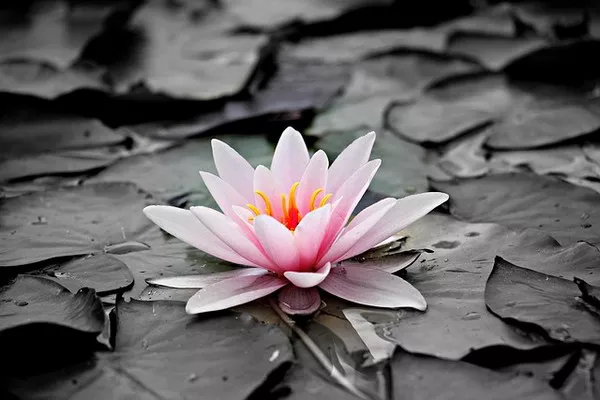The lotus flower, with its exquisite form and profound symbolism, has captivated cultures and civilizations across the world for centuries. Rooted in ancient mythology, spirituality, and art, the lotus holds a deep and enduring meaning that transcends time and borders. From its emergence in muddy waters to its radiant bloom, the lotus serves as a powerful metaphor for transformation, enlightenment, and resilience. This article delves into the intricate meaning of the lotus flower, exploring its significance across various cultures and its timeless messages that continue to inspire humanity.
A Symbol of Purity and Enlightenment
The lotus flower is often revered as a symbol of purity and enlightenment, a representation of the journey from darkness to light. Its growth cycle, emerging from the depths of muddy waters to bloom above the surface, is seen as a metaphor for spiritual awakening and personal transformation. This symbolism can be found in several major belief systems and cultures.
Lotus Symbolism in Buddhism:
In Buddhism, the lotus flower holds immense significance. It is associated with purity of mind and spirit, untouched by the external world’s impurities. The lotus grows in stagnant waters yet remains pristine and beautiful, symbolizing the potential for enlightenment amidst the challenges of life. The image of a Buddha sitting or standing on a lotus flower reflects the attainment of a state of enlightenment while remaining untouched by the troubles of the material world.
Lotus Symbolism in Hinduism:
In Hinduism, the lotus is a sacred symbol of divine beauty and purity. The deity Brahma, the creator of the universe, is often depicted sitting on a lotus that emerges from the navel of Lord Vishnu. This portrayal underscores the idea that creation and enlightenment can arise from even the most unlikely of places. The unfolding petals of the lotus are likened to the expansion of the soul and the blossoming of spiritual knowledge.
Resilience and Endurance
The lotus flower’s remarkable ability to grow and bloom in the midst of challenging conditions serves as an inspiration for resilience and endurance. Despite its humble beginnings in murky waters, the lotus emerges unscathed, demonstrating the human capacity to overcome adversity and thrive against all odds.
Cultural Reflections
Egyptian Culture:
In ancient Egyptian culture, the blue lotus (Nymphaea caerulea) held a special place. It was associated with rebirth and the sun’s daily cycle, as the flower closes at night and opens again in the morning. The blue lotus was also believed to have hallucinogenic and relaxing properties and was often used in religious rituals.
Chinese Culture:
In Chinese culture, the lotus is revered for its associations with purity, harmony, and beauty. The flower is a symbol of moral integrity, as it remains untainted despite growing in muddy water. The lotus is often depicted in art and literature, embodying elegance and grace.
Japanese Culture:
In Japanese culture, the lotus is a symbol of purity, enlightenment, and rebirth. The concept of “mudita,” which means finding joy in the success and happiness of others, is often associated with the lotus flower. This stems from the lotus’s ability to grow in mud but produce a beautiful bloom, reflecting the potential for goodness in all beings.
FAQs about the Lotus Flower
1. What does the color of the lotus flower symbolize?
The color of the lotus flower holds additional layers of meaning. White lotuses symbolize purity, spiritual enlightenment, and mental purity. Red lotuses represent love, compassion, and the heart’s qualities. Blue lotuses are often associated with wisdom, knowledge, and victory over the senses.
2. Are there any scientific facts about the lotus flower’s resilience?
Yes, the lotus effect, also known as the “self-cleaning” effect, is a scientific phenomenon observed in lotus leaves. Due to the microscale structure of its leaves, water droplets roll off easily, carrying away dirt and debris. This self-cleaning mechanism has inspired advancements in material science, leading to the development of water-resistant coatings.
3. Can the lotus flower’s symbolism be applied to personal growth?
Absolutely. The lotus flower’s journey from the depths of muddy waters to its exquisite bloom can serve as a powerful metaphor for personal growth and transformation. It encourages individuals to embrace challenges, learn from them, and emerge stronger and wiser.
4. How has the lotus flower influenced modern art and design?
The lotus flower’s profound symbolism has influenced various art forms and design elements. Its elegant form and rich symbolism often find expression in paintings, sculptures, jewelry, and even tattoos. The lotus continues to inspire contemporary artists and designers worldwide.
5. What role does the lotus flower play in modern spiritual practices?
The lotus flower remains a prevalent symbol in modern spiritual practices, often used as a focal point for meditation and mindfulness. Its symbolism of growth, transformation, and inner purity resonates with individuals seeking personal development and spiritual awakening.
Conclusion
The lotus flower, with its intricate symbolism and timeless appeal, has transcended cultural boundaries to become a universal emblem of purity, enlightenment, and resilience. Its journey from the depths of mud to the luminous surface mirrors the human quest for growth and spiritual awakening. Through its depiction in art, literature, and religious iconography, the lotus continues to inspire individuals to overcome challenges, embrace transformation, and strive for higher states of consciousness. In a world where change is constant and challenges are abundant, the lotus flower serves as a reminder that beauty and growth can emerge from even the most challenging of circumstances.


